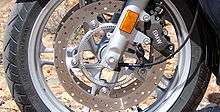Sequential manual transmission
| Transmission types |
|---|
| Manual |
| Automatic |
| Bicycle gearing |
A sequential manual transmission (or sequential manual gearbox) is a non-traditional type of manual transmission used on motorcycles and high-performance cars for auto racing, where gears are selected in order, and direct access to specific gears is not possible.
With traditional manual transmissions, the driver can move from gear to gear, by moving the shifter to the appropriate position. A clutch must be disengaged before the new gear is selected, to disengage the running engine from the transmission, thus stopping all torque transfer. This type of transmission is often referred to as a H-pattern because of the path that the shift lever takes as it selects the various gears. As the gear shifting process requires attention and dexterity that might be needed in managing sharp corners in car races, sequential transmission has been introduced into many competition rules as an alternative.
A true sequential transmission will very often use dog clutch engagement rather than the more usual synchromesh as fitted to a normal H-pattern road car gearbox. Engagement using dogs requires only a very brief interruption of engine torque to complete a shift into any adjacent gear. This allows shifting between gears without the use of the clutch. The clutch would normally be used only for standing starts.
Overview

Sequential manual transmissions work by providing the driver with the ability to select the gear directly before or after the gear currently engaged. Usually the shift lever is pulled back to select the adjacent higher gear and pushed forwards to select the adjacent lower gear. On a true sequential gearbox, the shift lever operates a ratchet mechanism that converts the fore & aft motion of the shift lever into a rotary motion. This rotary action turns a selector drum (sometimes called a barrel) which has three or four tracks machined around its circumference. Running in the tracks are the selector forks, either directly, or via selector rods. These tracks deviate around the circumference and as the drum rotates, the selector forks running in the tracks are moved to select the required gear. Only a true sequential transmission has a shift mechanism that operates in this way.
Sequential gearboxes are also used in nearly all modern motorcycles as it is too cumbersome to have a conventional H-pattern shifter and would take up too much space in the confines of a motorcycle frame. Having control over the gear shifter, typically with the rider's left foot, frees their hands to operate both the clutch and brake without letting go of the handlebars.
Sequential manual transmissions are true manual transmissions, and should not be confused with automatic transmissions that provide some degree of user shifting input. One commercial example of this type of automatic transmission is the Tiptronic transmission. User shifting through buttons or lever does not necessarily mean that the transmission is a manual transmission.
Benefits
Beyond the ease of use from a driver's standpoint, an additional benefit of sequential manual gearboxes is that use of the clutch via foot pedal or hand control can be minimized or completely obviated, with the clutch used only for starting from a complete stop. Formula One cars of the 1990s made the most high-profile debut of this technology in motor sports, and enhanced variations on this theme are still in use in many forms of road racing and drag racing today. The simple push-pull action of the shift mechanism also lends itself to semi-automatic control using either hydraulic or pneumatic actuators—a system often referred to as paddle-shift. Instead of a manual gear lever, the driver is provided with (usually) a pair of flipper paddles on the steering wheel, rally cars often utilize just a double-acting single paddle. Pulling on the right-hand paddle makes an up-shift and pulling on the left-hand paddle makes a down-shift. The paddle-shift system will use a sophisticated electronic control unit to provide the necessary logic to operate the shift mechanism. This type of paddle-shift system fitted to race and rally cars should not be confused with most of the current crop of paddle-shift systems fitted to some high-end road cars. These systems often use a dual-clutch transmission or a conventional torque converter automatic transmission which allow driver input to select the gears.
Perceptions
While a sequential manual transmission can (depending on the model) offer faster shift speeds and thus faster race times, many road-car-driving enthusiasts prefer a standard manual transmission, which—with a clutch pedal and the ability to skip gears—allows more driver input and a more traditional driving experience.[1]
References
- ↑ Frank Marcus. "BMW M3 SMG - Short Take Road Test - Auto Reviews". Car and Driver. Retrieved 2011-08-29.
